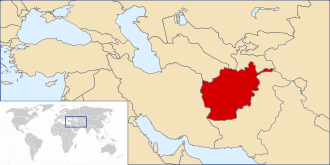History of malacozoology of Afghanistan
The earliest reports on Afghanistan molluscs consists of scattered descriptions of materials gathered on various military expeditions. [1] Only the reports of Thomas Hutton (zoologist) (1834, 1849–1850), [2] [3] who recorded 21 species, and César Marie Félix Ancey (1893), [4] who listed 27 taxa, are at all comprehensive. [1] Nelson Annandale & Baini Prashad (1919) [5] issued a voluminous report on freshwater collections from the southwestern deserts, and Jaeckel (1956) [6] recorded 27 species taken by an entomological survey team (see Klapperich, 1954). [1] [7] Jaeckel (1956) summarized previous work, evaluated records, and concluded that there were 37 species known from Afghanistan. [1] Ilya Mikhailovich Likharev & Yaroslav Igorevich Starobogatov (1967) [8] had available extensive materials taken from 127 collecting stations between 1957 and 1962. [1] Their report covered 53 species represented by new material, with an additional 14 names carried over from earlier reports, but not verified from their collecting. [1]
Alan Solem have reported 10 new taxa (3 newly described species and 6 found species) that were previously not known from Afghanistan in 1979. [1] Up to 1979, 73 taxa of molluscs have been recorded from Afghanistan. [1]
It is obvious that knowledge of the Afghanistan molluscan fauna is in a very preliminary stage. [1] The same statements apply to surrounding areas, with the exception of Turkmenistan, Uzbekistan and Tajikistan in the north (that were part of the U.S.S.R. at that time), where the summary volumes of Likharev & Rammel'meier (1962) [9] and Anatoliy Alexeyevich Schileyko (1978) [10] provide a solid basis of comparative knowledge. [1] The probability of additional taxa existing is very high, particularly among the Helicoidea and Enidae. [1] Since the Street collections (from Street Expedition of 1962-1963) were made incidentally to mammal collecting, the relatively high percentage of unrecorded taxa suggests that only the tip of Afghanistan molluscan diversity has been sampled. [1] In the 2000s the molluscan fauna is still incompletely known (also with the neighbouring Iran). [11]
This page is based on this
Wikipedia article Text is available under the
CC BY-SA 4.0 license; additional terms may apply.
Images, videos and audio are available under their respective licenses.


